Tech heavy hitter Google is a major player in the thriving smart home market, thanks to its ‘nest’ of smart devices. From audio and video streaming to around-the-clock security, the Nest line-up brings all sorts of smart technologies. With a smartphone or tablet in hand, you can tap into a range of features both at home and from afar.
In addition, Google’s at-the-ready digital assistant, Google Assistant, provides various voice control options. You can draw on Google Assistant to manage a variety of tasks and operate compatible devices around your home.
In the following guide, we take a look at Google Nest, what you should consider when setting up Google Nest, and a few Google Nest devices.

What is Google Nest?
Nest is Google’s portfolio of smart home products. It includes speakers, displays, smoke detectors, cameras, doorbells and wi-fi routers. So from keeping tabs on your household while you’re out and about, to scheduling your day in detail, setting reminders, or streaming music, chances are there is a Google device that will get the job done.
Nest devices generally connect with the Google Home app. This allows for central access via your smart device. Google Home puts a range of features at your fingertips, allowing you to set up, manage and control Nest devices plus a range of other compatible devices.
And if your hands are busy there’s always Google Assistant. As mentioned above, Google Assistant, which Google describes as “your own personal Google, always ready to help”, integrates with the Nest line, paving the way for voice control.
The Nest portfolio has been steadily growing in recent years, and Google regularly brings new products to market. As we cover in the next section, set-up options vary slightly depending on the devices you’re running.
→Related article: Smart Speakers: A Buyer’s Guide
Google Nest set-up: Factors to keep in mind
Whether you’re just getting started with your smart home, or already own a number of smart products, there is a range of factors you should keep in mind if you’re considering purchasing a Nest device.
Top of your list should be smartphone or tablet compatibility, as you need to link Nest devices to get them up and running. Nest products run on all phone types, but your phone’s age could be a factor. Whether that’s the age of your phone or the operating system you’re running. You should refer to Google’s device-specific advice to determine if your version of Android or iOS is compatible.
In addition, if you’re already running other smart home devices, it’s worthwhile determining if they are compatible with any Nest products you’re looking to add.
Other factors to keep in mind include (specific set-up steps will vary depending on your Nest device and the smart device you are linking it to):
- Google account – you need a Google account to get started. If you already have a Gmail address, you’ll be good to go
- Google Home app – you need the latest version of the app, which takes you through the set-up process for different devices
- Nest app – some devices require the Nest app for set-up. Depending on the device, you may be able to link it to the Google Home app
- Google Assistant – if you’re using an iOS device, you may also need to download the latest version of Google Assistant
- Nest Aware – is a paid subscription service offered in conjunction with some Nest devices, encompassing a range of upgraded features (it is worthwhile determining what features you require, and factoring in any additional costs, prior to purchase)
Of course, when adding devices to your home network set-up, you also need to ensure that they are in wi-fi range, and that your home network is set up to deliver speedy and seamless connectivity.
Google Nest line-up: from smart displays to smoke detectors
The Nest line-up encompasses a number of devices, and continues to evolve. As advised above, it’s worthwhile considering how individual devices will slot into your smart home set-up.
The following are some of the more recently released Nest devices.
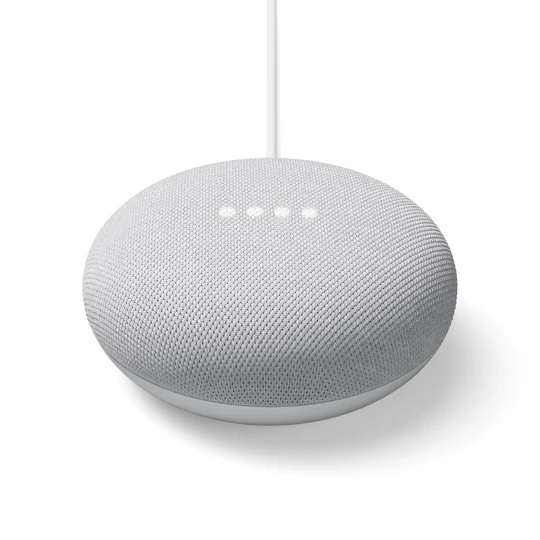
Nest Mini (2nd Gen)
Google’s Nest Mini (2nd Gen) is a compact smart speaker. It’s designed for easy placement around your home. It may be small in size, but the disc-shaped device incorporates a wide range of features, and can take on a central role in your connected home set-up.
The Nest Mini can stream music and other audio and overall has good sound quality. Although its strong suit isn’t as a room-filling sub-heavy speaker. Rather its main strengths lie in how it allows you to use a range of Google Assistant voice commands. Ask the weather, hear the latest news report, Google something while making breakfast, and so on. This also enables voice control of compatible smart devices in your home (from smart lights to smart TVs).
- Digital assistant – Google Assistant built-in
- App control – Google Home (Android and iOS)
- Physical controls – capacitive touch controls
- Connectivity – wi-fi 5, 2.4 and 5GHz; Bluetooth 5.0; Chromecast built-in
- Dimensions – diameter 98mm, height 42mm; 177-183g
- Power – mains power
Price – the Nest Mini can be found online for around $44*
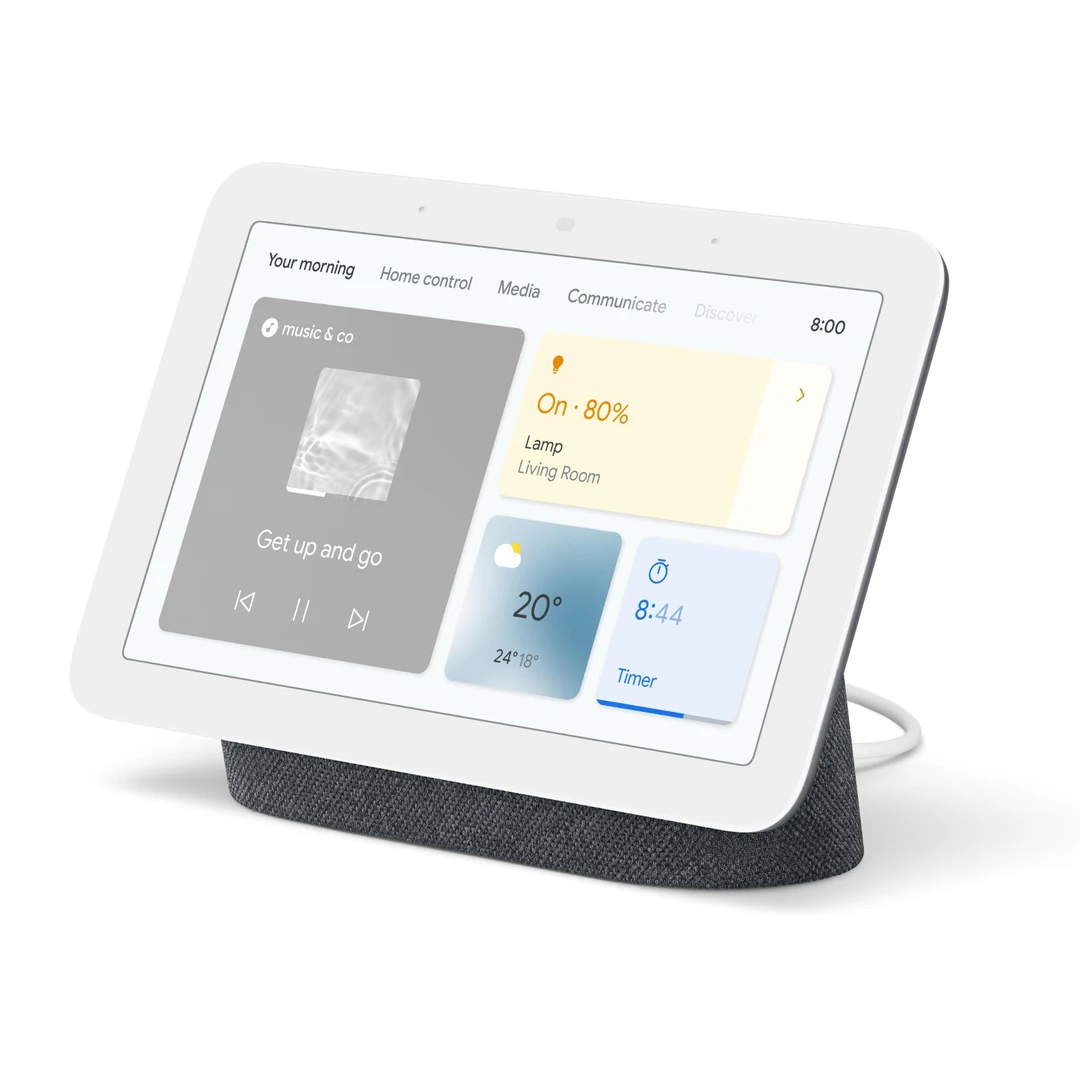
Nest Hub (2nd gen)
The Nest Hub (2nd gen) is a smart display that can be positioned as required around your household. The Nest Hub is a tablet-like device that acts as a central point in your connected home. It’s a bit like a Nest mini, but with a screen.
The Nest Hub streams video and audio, enables control of compatible devices via its central display (for instance, if you’re running a compatible camera, you can bring up a live feed), and allows for a range of voice commands via Google Assistant.
In addition, Quick Gestures lets you control many Nest Hub features via a wave of your hand. Sleep Sensing, using motion and sound to analyse your sleep, designed to help improve the way you sleep, is another notable feature of the Nest Hub.
- Display – 7-inch touchscreen (1024 x 600 resolution)
- Digital assistant – Google Assistant built-in
- App control – Google Home (Android and iOS)
- Connectivity – Wi-fi 5, 2.4 and 5GHz; Bluetooth 5.0.
- Dimensions – 120.4 x 177.4 x 69.5mm; 558g.
- Power – mains power.
Price – the Nest Hub can be found online for around $79*
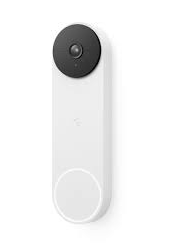
Nest Doorbell
The Nest Doorbell is a battery-powered video doorbell sporting smart technology. It allows you to see what is happening at your door, receive alerts when there is activity, and communicate with visitors when you are not at home via a built-in speaker and microphone.
It can tell the difference between people, packages and vehicles, with alerts sent to your smart device. You can access three hours of event video history, and if your wi-fi goes down or there’s a power outage, it will automatically store up to one hour of recorded events in its local memory.
Nest Aware subscriptions include features such as saving up to 60 days of event video history, and notifications when a familiar face is at the door.
- Camera – 1/3 inch, 1.3MP colour sensor, 6x digital zoom, 3:4 aspect ratio, 160° diagonal field of view; night vision up to 3.05m
- Video – HD (960 x 1280 resolution) up to 30fps, 24/7 live view, Night Vision, HDR, H.264 encoding
- App control – Google Home (Android and iOS)
- Connectivity – Wi-fi 4, 2.4GHz; Bluetooth Low Energy
- Weather resistance – IP54 weather resistant
- Dimensions – 46 x 24.1 x 160mm; 206g
- Power – built-in rechargeable lithium-ion battery (or use existing wiring for chime and recharging)
Price – the Nest Doorbell can be found online for around $290*
→Related article: How to Keep Safe with the Best in Smart Home Security
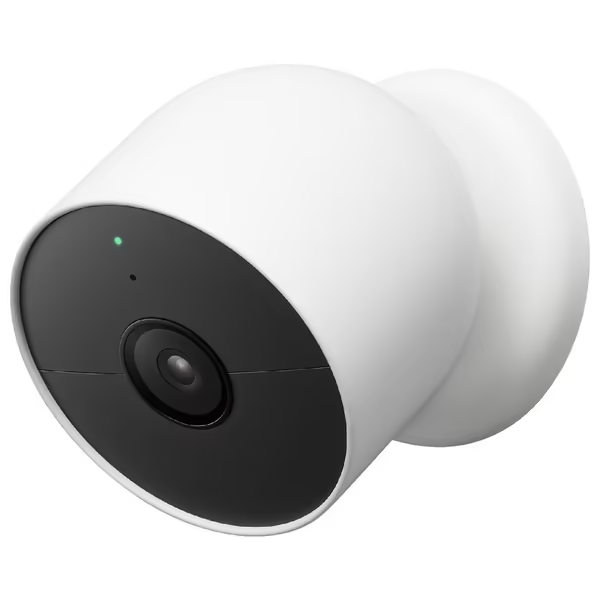
Nest Cam
The Nest Cam is a battery-powered outdoor or indoor camera decked out with a number of smart features. It is designed to help you look after your home, allowing you to customise alerts, such as for people, animals and vehicles.
You can check on the live feed, and talk through the camera with two-way audio. As with the Nest Doorbell, you can access three hours of event video history, and if your wi-fi goes down or there’s a power outage, it will automatically store up to one hour of recorded events in its local memory.
Nest Aware subscriptions include features such as accessing up to 60 days of event video history, and notifications when a familiar face is at the door.
- Camera – 6.46mm 2MP sensor, 130° diagonal field of view, 6x digital zoom, 16:9 aspect ratio
- Video – up to 1080p at 30fps, HDR, 24/7 live view, Night Vision, HDR, H.264 encoding
- App control – Google Home (Android and iOS)
- Connectivity – Wi-fi 4, 2.4GHz; Bluetooth Low Energy
- Weather resistance – IP54 weather resistant
- Dimensions – 8.3 x 8.3cm; 398g
- Power – built-in rechargeable lithium-ion battery.
Price – the Nest Cam can be found online for around $289 (single), $529 (two pack) and $749 (three pack)*
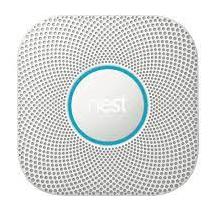
Nest Protect
The Nest Protect is a smoke and CO alarm. But, as with everything Nest, it is kitted out. It features an industrial-grade smoke sensor, is designed to test itself automatically, and lasts up to a decade. It also has a human voice that can warn and tell you where the danger is. So long as you have the Nest Protect in multiple rooms these can work together to locate the danger and inform you where it is.
The Nest Protect can send alerts to multiple household members, wherever they are, and you can silence the alarm with the Nest app if required. When the battery is running low, the Nest Protect will send a message to your smart device, and you can carry out testing with a tap.
- Split-spectrum sensor – uses two wavelengths of light to detect smoke from both fast-burning and smouldering fires
- Carbon monoxide sensor – keeps working for up to a decade
- Lighting – lights up as you walk underneath it at night (RGB colour ring with six LEDs, using colours to communicate different messages)
- Steam check – uses custom algorithms and a humidity sensor to look for steam
- App control – Nest
- Connectivity – Wi-fi 4, 2.4 GHz; Bluetooth Low Energy
- Dimensions – 13.5 x 3.85 x 13.5cm; 379g (battery), 375g (wired)
- Power – battery (six long-life AA batteries) or wired
Price – the Nest Protect can be found online for around $219
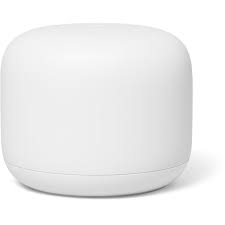
Nest WiFi
Google’s Nest Wifi is a mesh router, comprising the main router and a number of additional access points (Nest Wifi points), designed to blanket your home in wi-fi coverage. Each Nest Wifi point also has a speaker and is equipped with Google Assistant.
The number of Nest Wifi points you require will depend on the layout of your household, with the Nest Wifi router typically available for purchase on its own, or as a pack with either one, two or three Nest Wifi points.
- Wi-Fi – Wi-fi 5, 2.4 and 5GHz; MU-MIMO, beamforming and band steering
- Speed – AC2200 router, up to 2200Mbps; AC1200 points, up to 1200Mbps
- Processor – quad-core processor
- Ports – the router is equipped with dual gigabit Ethernet ports
- App control – Google Home (Android and iOS)
- Security – WPA3
- Dimensions – the router has a diameter of 110mm, a height of 90.4mm and weighs 380g; the points have a diameter of 102.2mm, a height of 87.2mm and weigh 350g
Price – the Nest Wifi router (one pack) can be found online for around $199, the Nest Wifi router (two pack – router and one point) for around $389, and the Nest Wifi router (three pack – router and two points) for around $589*.
*Further information on pricing can be found at individual retailer websites. This should be used as a starter guide and not considered an actual quote.
Compare broadband providers for free with Canstar!
About the author of this page
![]() This report was written by Canstar author Martin Kovacs. Martin is a freelance writer with experience covering the business, consumer technology and utilities sectors. Martin has written about a wide range of topics across both print and digital publications, including the manner in which industry continues to adapt and evolve amid the rollout of new technologies
This report was written by Canstar author Martin Kovacs. Martin is a freelance writer with experience covering the business, consumer technology and utilities sectors. Martin has written about a wide range of topics across both print and digital publications, including the manner in which industry continues to adapt and evolve amid the rollout of new technologies
Enjoy reading this article?
You can like us on Facebook and get social, or sign up to receive more news like this straight to your inbox.
By subscribing you agree to the Canstar Privacy Policy


Share this article